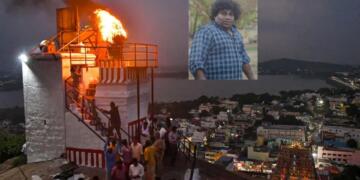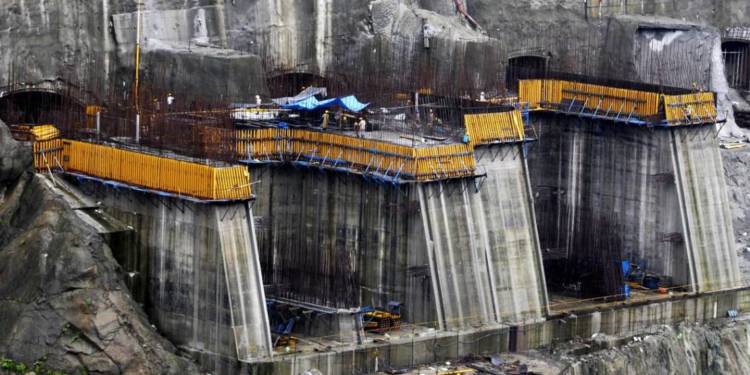There has always been a debate about whether development should precede ecological concerns or vice-versa. It’s a critical question that India as a developing country faces as there is a clear cut need to balance development with sustainability.
There have been umpteen examples where development projects have been stalled by environmentalists under the garb of protecting the ecology which have the backing of foreign-funded NGOs in their endeavours to halt India’s pace of development.
While Mumbai’s population has continued to grow exponentially, it doesn’t have the required infrastructure to sustain such a huge population as the previous NCP-Congress government lacked the will to execute large-scale infrastructure projects. The present BJP government has certainly shown the intent to execute such projects and hence have fast-tracked all the pending infrastructure projects.
From a new Airport at Navi Mumbai to the Versova-Bandra Sea Link and the finally the bullet train route between Ahmedabad and Mumbai, the latter is amidst infrastructure projects worth over Rs 200,000 crore with most of the projects continuing to exist only on paper before Fadnavis decided to alter the status quo.
However, the projects are facing hurdles from the environmentalists and a few weeks ago, the Bombay High Court quashed the Coastal Regulation Zone (CRZ) approval for the Coastal Road and the CRZ clearance for a casting yard at Juhu set up for VBSL with the Supreme Court upholding the order.
The Bombay High Court order said that the project needed environmental impact assessment (EIA) and noted not only that there were “serious lacunae” in the decision-making process but also a lack of proper scientific study.
The recent protests to develop a metro shed at Aarey has again brought the debate of sustainability and development in the spotlight. While without a doubt, some of the concerns raised by the protesters are genuine and must be looked at but there are various environmentalists amongst the protestors with vested interests.
It is a common practice for the environmentalists to approach the courts after the tenders have been awarded instead of going before the tenders are awarded.
This leads to the projects getting stalled and wastage of public money. The widening of NH-7 is another example where the Bombay HC had to step in to ensure that the widening of the crucial highway isn’t stalled. The Nagpur Bench of Bombay HC slammed those opposing the construction of highway, saying that if the development of the country is stopped, then “judicial terrorism is necessary”.
Goa is the tourist hotbed of India and due to the influx of tourists, the state is in dire need of another airport. The government had got the required Environment Clearance for building the second airport at Mopa, Goa. However earlier this year, despite having availed an EC from the National Green Tribunal, the Supreme Court chose to suspend the EC by citing UN-sanctioned Sustainable Development Goals.
At a time when obtaining an EC is extremely difficult from conservative bodies like the NGT, this decision of the SC will make the investors think twice before investing in an infrastructure project in India as such decisions only increase the ease and cost of doing business in India as the 2,000 odd manpower and machinery mobilised for the project lies in a chaos.
The Intelligence Bureau in its report in 2014 claimed that Foreign-funded NGOs were stalling India’s development. The report claimed that the NGOs are “serving as tools for foreign policy interests of western governments” by sponsoring agitations against nuclear and coal-fired power plants across the country.
The report further stated that the NGOs work roughly through a network of local organisations like the Narmada Bachao Andolan and have negatively impacted India’s GDP by 2-3%.
The government came under heavy fire as in the report the IB accused ‘Greenpeace’ of receiving Rs. 45 crore from abroad in the past 7 years to oppose the building of coal-fired plants in India with companies like Coal India Limited, Hindalco and Aditya Birla group emerging as the NGO’s major targets.
The recent case of Sterlite Plant and the subsequent losses incurred is a prime example of environmentalists trying to stonewall India’s development.
Sterlite Copper faced large scale protests as the protesters demanded the closure of the company’s copper smelter plant. The firm was open to allow the NGOs and environmentalists to visit inside the plant to assuage their concerns but they steadfastly refused to enter its premises since the past 7 years and still claim to know that the plant would be ecologically harmful and despite an open newspaper advertisement run by the company inviting everyone to the plant, the environmentalists refused by some baffling logic that there is more pollution outside rather than inside.
Comically, the environmentalists alleged that the firm lets out effluents into the sea completely ignoring the fact that the firm doesn’t have a 15-km pipeline to let out effluents into the sea.
P Ramnath, CEO of Sterlite Copper said: “NGOs are being used as a vehicle to destabilise the industry. They have links with Foil Vedanta in the UK, which is funded by various foundations, and they want to do the same here. They claim to be environmentalists, but they neither listen to us nor offer solutions. Their only objective is to shut down the plant.”
Sadly, the Supreme Court has put a hold on the plant and the company is facing losses in the tune of thousands of crores as the company has already invested Rs 2,500 crores. Such cases will certainly hamper the amount of Foreign Portfolio Investments in the country.
Perhaps, it was the Narmada Bachao Andolan which started it all. The Sardar Sarovar Dam was one of the most critical projects which faced stinging criticism from the likes of Medha Patkar and the ilk. Needless to say, it was more of a politically motivated protest aimed at the then-Gujarat CM Narendra Modi who in turn went on a 51-hour fast to ensure that the project isn’t stalled.
The World Bank had earlier agreed to fund the project but withdrew their offer after the protests by the environmentalists.
Narendra Modi just 17 days into his first term as the PM, removed all the hurdles required to build the dam and India went onto build the dam on its own without any help from the World Bank.
The Prime Minister while laying the foundation stone for the project claimed that conspiracies were hatched to stall the project along with massive misinformation on the alleged environmental impact of the project. PM Modi was quoted during a rally in 2017: “No other project in the world has faced as many hurdles as the Sardar Sarovar Dam. There was a tirade of false allegations at us and several conspiracies were hatched to stall this project. But we were determined not to take make it a tool for political disputes.”
The recent protests against the hydropower projects in Arunachal Pradesh are further proof of the NGOs and their anti-national activities. Arunachal Pradesh is a critical state which shares its borders with China, with the latter attempting to make territorial gains with its nefarious activities in the state.
The hydropower projects are of crucial importance to ensure the flow of Brahmaputra in the country given China’s attempts of reducing the flow and the Union government fears that China is funding the so-called NGOs to carry out widespread protests against its construction. China wants to ‘delay’ these projects and divert the water to arid zones of Xinjiang and Gansu under its ambitious $62-billion south-north water diversion scheme. If China can complete the diversion before Indian hydropower projects, its claim over water will be stronger as per international law.
The NGOs raised the issue that the site of the project is a habitat for many ‘endangered species’ including black-necked crane, and other birds. In the name of protection of the wildlife, the NGOs organized a protest against the dams. China plans to assert its claim over Arunachal Pradesh by building a dam over Brahmaputra’s tributary as more than 100 private hydropower projects, with a capacity of 35 GW, are waiting to take off due to regulatory cholesterol and capital shortage.
There is no doubt that environment should be of the umpteen importance of any government given the increase in global warming, but it is critical to differentiate between genuine concerns and frivolous concerns which are aimed to halt India’s rapid pace of development. From India’s sovereignty to thousands of crores, a lot is at stake with the multitude of development projects and care must be taken to not allow anti-national NGOs to ply their trade in the country and halt India’s development.






























